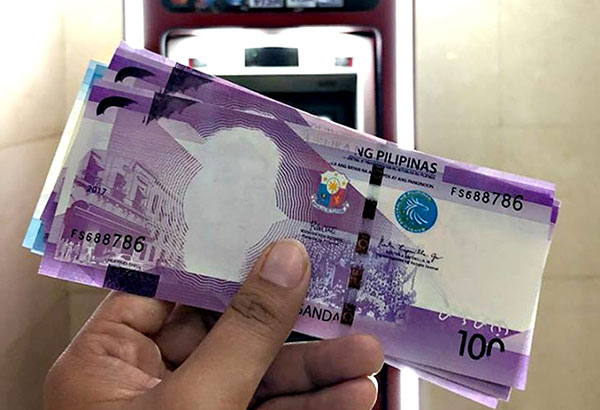Faceless P100 bills blamed on printing machine glitch

Photo from Earla Anne Yehey’s Facebook account shows her withdrawing P100 bills without the image of the late president Manuel Roxas. The Bangko Sentral ng Pilipinas, which blamed machine error for the misprint, said the faceless bills, which are valid legal tender, account for only 0.00009 percent of the total banknotes in circulation.
MANILA, Philippines — The Bangko Sentral ng Pilipinas (BSP) yesterday confirmed the existence of “faceless” banknotes and assured the public that such are legal tender.
The bills were withdrawn from the automated teller machines of Ayala-led Bank of the Philippine Islands (BPI), resulting from a glitch in one of its printing machines. These notes were delivered just last month.
Carlyn Pangilinan, managing director of the currency management sub-sector at the BSP, said in a press conference that initial investigation showed the bills originated from the central bank.
“Having found these to be issued by the BSP, an inquiry was made into the printing-machine error that it caused,” she said.
She said the glitch was caused by one of the rollers of its printing machines, affecting a few sheets of P100 bills with 50 pieces of banknotes per sheet.
“There is no 100 percent correct production process,” she added.
A Facebook post of four P100 bills without the face of President Manuel Roxas withdrawn by a certain Earla Anne Yehey from a BPI ATM on Christmas Day went viral.
Pangilinan explained that the incident actually represents isolated cases experienced by a few individuals.
The incident reportedly affected two ATMs of BPI in Eastwood City and Libis as well as Glorietta in Makati City.
According to her, the BSP prints millions of banknotes on a daily basis and the faceless bills only accounted for 0.00009 percent of the total banknotes in circulation.
“In the manufacturing and production process, there are cases when machine errors cause rare misprints. In this particular case, the BSP has identified the mechanical cause of the erroneous printing. It has since been resolved,” Pangilinan said.
She pointed out the BSP documented 33 pieces of faceless P100 bills, of which 19 were turned over by BPI.
Pangilinan said BPI removed all the P100 bills in order to control the problem when it was posted on social media.
Right now, she said the BSP is reviewing its quality assurance process that is mostly done by machines.
“It was manually done before but now it is all machines. We have to do some improvements in our process and talk to the suppliers of the machines to prevent a repeat of this situation,” she said.
BPI spokesman Owen Cammayo said the bank would continue to work with the BSP in retrieving and replacing the affected bills.
“Customers may go to our branches to have the faceless bills replaced, following standard BSP verification procedures,” he added
The BSP official added that there were some misprints before involving P50 bills but this was detected by the teller of a certain bank.
However, this is the first time misprinted banknotes were loaded in ATMs.
Pangilinan encouraged the individuals affected to turn over the misprinted notes.
“The BSP assures the public that it has, through the years, observed a procedure of quality assurance for the millions of banknotes it daily prints and circulates as legal tender,” she said.
Likewise, the BSP acknowledges observations on the design and specifications of the P5 new generation currency (NGC) coin released this month that have similarities with the existing P1 coin.
To alleviate any confusion, the BSP highlighted the differences between the two coins: The P5 NGC coin is heavier (7.4 grams), thicker (25 millimeters) and slightly larger than the P1 coin.
Moreover, the P5 NGC coin’s sides are smooth while the P1 coin has ridges and the designs of the two coins are distinctly different.
Filipino hero Andres Bonifacio along with the markings “ANDRES BONIFACIO” and “5 PISO” are prominently featured in the obverse of the P5 coin.
Its reverse features the Tayabak, a Philippine endemic plant, the BSP logo and “Bangko Sentral ng Pilipinas” in microprint.
Issuance of the NGC coins, their design, features and specifications was the result of an extensive and in-depth study by two expert committees of the BSP – the Numismatic and the Currency Management committees.
The need to enhance the security features of coins using the latest technology in minting given counterfeiting; the need to change coins’ metallic composition to discourage acts of illegal extraction of their metal content; and the need to adapt more cost-efficient production processes, provide rationale for the change.
- Latest
- Trending
































